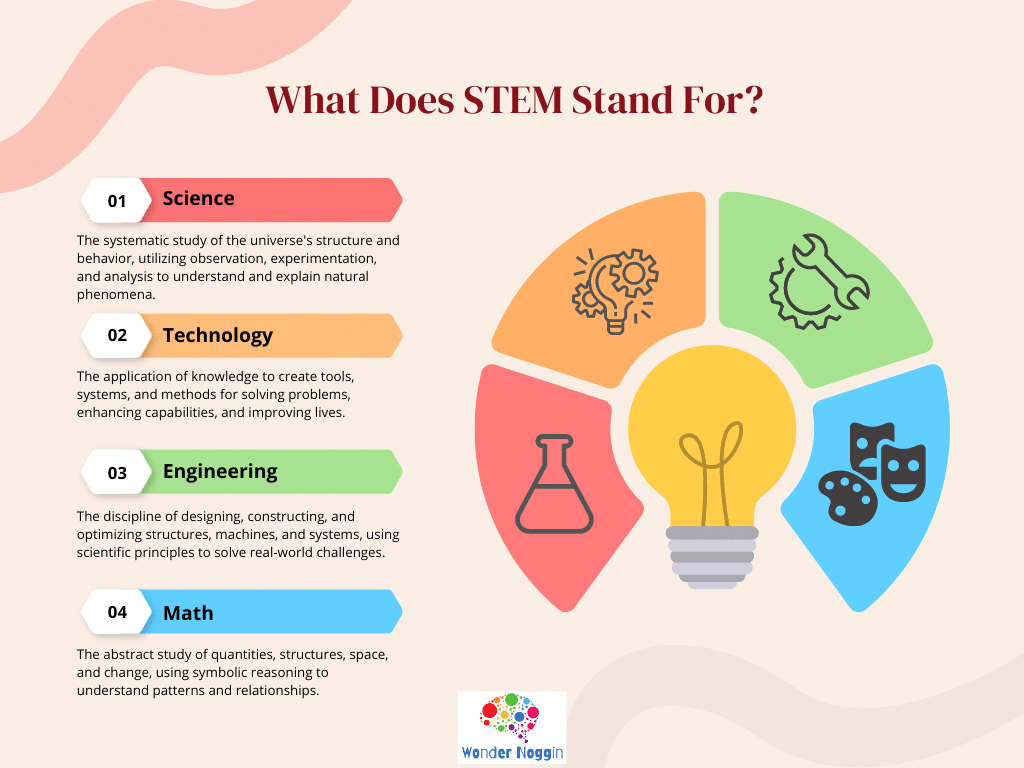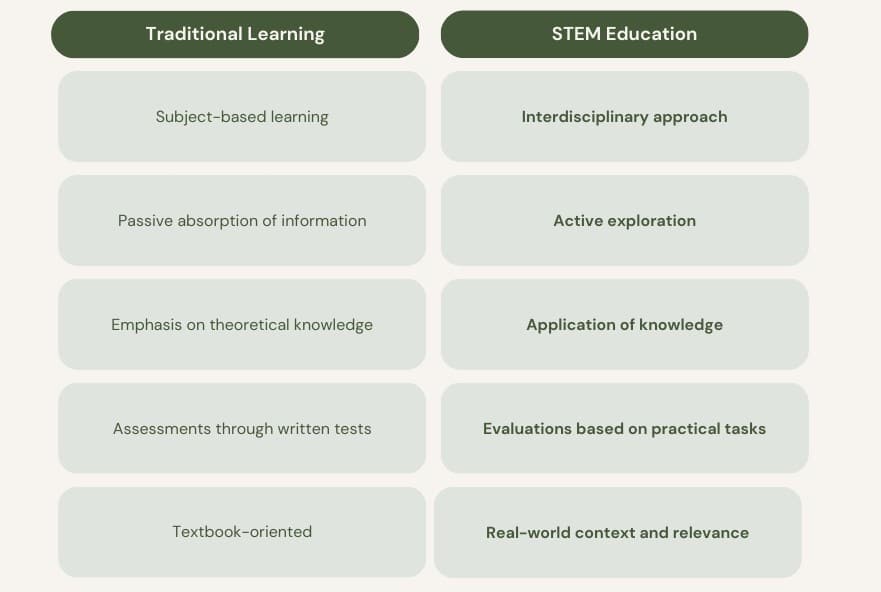I remember the day I discovered the term STEM and its potential for my son’s education. It felt like deciphering an alien language, but I was determined to crack the code.
I found myself asking out loud, “What is STEM in education?”
Why is it so important in education? And how on earth could I, a busy mom with no teaching background, bring it into our home?
Don’t worry, friends, I’ve taken the journey, and now I’m here to share my discoveries with you. So grab a cup of your favorite brew, get comfortable, and let’s unravel the mystery of STEM together.
We’re about to dive into a world of hands-on learning that can light a spark in our children’s eyes and minds right from our kitchen tables! So stick with me. It’s going to be an enlightening ride!
What Does STEM Mean?
Let’s take a moment to tackle the question you’ve been pondering: What on earth is STEM?
STEM stands for Science, Technology, Engineering, and Mathematics.
The STEM movement was first introduced in 2001 by the U.S. National Science Foundation (NSF) to address the growing worry that young children were not prepared for the demands of STEM occupations in the 21st century.
These subjects are all like good friends, linking arms in theory and in practice, and STEM learning can help your little ones improve their education and retention of information compared to traditional learning techniques.
STEM education extends beyond traditional school subjects, providing a valuable skill set that shapes our thinking and behavior.
In this blog post, we will look at what STEM means, the benefits of STEM for childhood education, and how you can support your child’s educational journey with STEM at home!
Unpacking The STEM Acronym
Do you ever wonder what the acronym STEM means and how to navigate the exciting world of supporting your little ones at home through STEM?
If so, just know that you are not alone!
I have been working with my son on STEM-related subjects for years, and many parents I talk to are doing the same for their young learners.
The key thing I discovered with STEM is that the real power lies in how each discipline works together instead of each STEM subject on its own. STEM takes on a new dimension when you realize how different STEM subjects work together to improve the whole learning experience for kids.
To help you understand the overall power of STEM, let’s take a deep dive into each part of STEM to see how the individual parts support each other.

1. Role of Science in STEM

Science is the cornerstone of STEM learning because it provides a foundation for us to learn about the world around us.
Science is a crucial part of STEM education for children because it equips them with the tools and confidence they need to build critical thinking skills problem-solving skills, and encourages curiosity and discovery. It also cultivates essential abilities such as teamwork, investigation, critical analysis, experimentation, and exploration.
What Topics Does Science Cover In STEM?
STEM science covers many topics, and here are the main areas and topics you can expect to help your little ones with as they study STEM science:
- Life Sciences: The study of living organisms, such as plants, animals, and human biology.
- Physical Sciences: The study of non-living systems like physics and chemistry, encompassing topics like energy, matter, and the forces of nature.
- Earth and Space Sciences: The exploration of geological processes, weather patterns, and the cosmos.
- Engineering Principles: Basic understanding of design, building, and problem-solving.
- Technology and Digital Literacy: Introduction to computers, coding, and the relationship between technology and science.
Why Is Science Important In STEM?
Learning science as a part of STEM education holds significant value for children, as it establishes a strong foundation for their understanding of the world. Here are five reasons why it’s crucial:
- Critical Thinking: Science fosters analytical thinking and problem-solving abilities, preparing children for complex real-world situations.
- Creativity and Innovation: It encourages innovation through hands-on experiments and activities, which can inspire future discoveries.
- Future-Ready Skills: Science lays the groundwork for future careers in fast-growing related fields such as biotechnology, environmental science, and health sciences.
- Real-World Application: It helps children understand and interact with their surroundings, aiding them in correlating classroom learning with real-world phenomena.
- Interdisciplinary Connection: Science often overlaps with technology, engineering, and mathematics, helping children see the interconnectedness of these disciplines and their relevance in everyday life.
Science in STEM plays a pivotal role in fostering a child’s curiosity, instilling critical thinking, and driving innovation. It’s easy to get your little ones involved with fun science STEM activities at home.
STEM science not only equips them with the knowledge to comprehend the world but also prepares them for future challenges and opportunities in an increasingly technology-driven society.
2. Technology’s Place in STEM

In STEM education, technology embodies the use of educational tools that bolster the learning and teaching process. It’s like the digital toolbox used by experts in science, engineering, and math.
Embracing technology within STEM gives our little ones a head start in digital literacy and practical skills in our ever-changing tech world. As they learn, it nurtures adaptability and imagination, shaping them into makers of technology, not just users.
The scope of technology in STEM is vast, covering knowledge about various tools, gadgets, and digital resources. It’s about teaching our kids to confidently navigate and create within the digital landscape.
What Topics Does Technology Cover In STEM?
Here are a few topics that your little ones will learn about as they adventure through STEM technology:
- Digital Literacy: Understanding the basics of using and interacting with digital technologies like computers, tablets, and software applications. Computer science is STEM, so kids learn how to interact with computers and other devices through STEM.
- Coding and Computer Programming: Learning kids coding languages is a key part of early STEM education because this is how your little ones will learn how to write code, create algorithms, and develop simple programs or games.
- Robotics: Building and programming robots, often involving elements of physical engineering and computer science. Robotics for kids is a great way to encourage your little ones to build the foundations of STEM and build their own robotics.
- Internet Safety and Ethics: Teaching children how to safely navigate the internet and understand the ethical considerations of digital technology.
- Data Analysis and Visualization: Introduction to collecting, interpreting, and visualizing data using technology, a skill applicable across various STEM-related fields.
Why Is Technology Important In STEM?
Learning technology as a part of STEM education equips children with vital skills and knowledge in our increasingly digital world. Here are five reasons why it’s important:
- Future Readiness: Technology skills prepare children for a future where digital literacy will be crucial in many careers.
- Critical Thinking Skills: Technological tasks often require problem-solving and analytical skills, enhancing children’s critical thinking capabilities.
- Creativity: Technology offers tools for creative expression and innovation, encouraging children to become creators, not just consumers.
- Digital Citizenship: Learning technology also involves understanding ethical and safety considerations and fostering responsible digital citizens.
- Empowerment: With technology skills, children can feel empowered to participate in, influence, and understand the digital world around them.
Technology in STEM catalyzes children’s creative and critical thinking abilities, transforming them into active creators in an increasingly digital world. You can help your little ones engage with technology through various technology STEM activities and involve them in everyday interaction with technology around your house.
3. Engineering: The E in STEM

Engineering holds a special place in STEM because it is a methodical and cyclical process for creating objects, procedures, and systems that fulfill human necessities and desires.
This STEM subject requires children to have a foundation of critical thinking and problem-solving skills, and engages young learners through activities like building and planning.
What Topics Does Engineering Cover In STEM?
Engineering in STEM provides children with a hands-on approach to learning, where they apply scientific and mathematical principles to design solutions for real-world problems. Here are some common areas and topics they’ll explore:
- Structural Engineering: Understanding the principles of building stable structures, like bridges or towers.
- Electrical Engineering: Introduction to electricity and electronics, potentially leading to simple circuit-building activities.
- Environmental Engineering: Projects focused on solving environmental problems, like designing a water filtration system.
- Aerospace Engineering: Exploring the basics of flight and space travel, perhaps through designing model rockets.
- Material Science: Learning about different materials and their properties, which influences the design of engineered solutions.
Why Is Engineering Important In STEM?
Engineering is a vital part of STEM education, teaching children to apply scientific and mathematical knowledge to solve real-world problems. Here are five reasons why it’s essential for children to learn engineering in STEM:
- Practical Problem Solving: Engineering teaches kids to apply their knowledge to find solutions to real-world issues
- Creativity and Innovation: It encourages children to think outside the box, fostering creativity and innovation
- Understanding the Built Environment: It helps kids understand and appreciate the infrastructure and technology they use daily.
- Career Opportunities: Engineering skills are highly sought after, opening a wide array of future career opportunities
- Environmental Awareness: It teaches kids how engineering can solve environmental problems, promoting sustainability.
Engineering in STEM represents the practical application of scientific and mathematical principles. You can help your little ones excel in engineering concepts through simple engineering STEM activities to create models, bridges, and towers, all while learning how to design, build, and test their ideas!
4. Mathematics As The Foundation Of STEM

In the world of STEM, you think of math as the trusty base camp for science, technology, and engineering.
It’s like the compass that helps us spot patterns in the data wilderness. These patterns can then lead us to investigate ideas, make solid decisions based on facts, and create models that mirror our natural world.
Through STEM math, children learn how to make sense of data, make exact measurements, and how understand the spaces and structures that make up our everyday life. The good news is that I put together a huge list of my favorite math activities for preschoolers, so you and your little learners can have fun and learn at the same time!
Mathematics isn’t just numbers. It’s a crucial part of our everyday adventure!
What Topics Does Math Cover In STEM?
Even at an early age, mathematics within STEM education offers a broad range of topics and skills that extend beyond traditional arithmetic. Here are some of the key areas and subjects children typically explore in STEM-oriented math studies:
- Number Systems: Understanding basic number properties, operations, and the relationships between different types of numbers.
- Geometry: Learning about shapes, spatial relationships, dimensions, and the principles that govern them.
- Algebra: Introduction to the concepts of variables, equations, and functions.
- Data Analysis: Learning to collect, interpret, and represent data graphically.
- Probability and Statistics: Studying the likelihood of events and understanding patterns, averages, and trends in data.
Why Is Math Important To STEM?
Learning mathematics as an integral part of STEM education is critical for children, as it provides them with skills that are applicable in a variety of settings. Here’s why it’s so important:
- Analytical Skills: Mathematics enhances logical thinking and problem-solving abilities, helping children to reason systematically.
- Interdisciplinary Application: Math principles are fundamental to understanding and applying concepts in science, technology, and engineering.
- Financial Literacy: Early exposure to math contributes to better financial understanding and management in adulthood.
- Confidence Building: Mastering mathematical concepts can boost children’s confidence and equip them with a sense of accomplishment.
- Real-world Problem Solving: From managing time to comparing prices or understanding statistics in the news, math skills help in navigating everyday life effectively.
Mathematics in STEM is a versatile tool that transcends traditional number crunching. Many parents (like myself) struggled with math as a kid, but you can help your child learn math with various STEM math activities to challenge and strengthen their understanding of math concepts.
How Does STEM Education Differ from Traditional Learning Approaches?
As we looked at in a previous section, STEM education offers many benefits to the overall learning experience for children and STEM students of all ages.
This is because STEM offers a comprehensive and accessible way for kids to learn about the world around them. Here are some specific examples of how STEM education differs from traditional learning approaches:
- Subject Integration: No more compartmentalizing subjects like they’re in separate boxes. STEM intertwines science, technology, engineering, and math, creating a more cohesive and interconnected learning experience.
- Knowledge Application: STEM goes beyond memorizing facts. It’s all about applying what you know to solve real-world problems. It’s like giving your kiddos a toolset, not just a textbook!
- Creativity: STEM encourages out-of-the-box thinking and creativity, lighting up those little imaginations in ways traditional methods might not.
- Activities: Hands-on activities in STEM make learning fun and interactive. Your kids might not even realize they’re learning – because they’re too busy having fun!
- Active Learning: STEM fosters active learning where kids take the lead, explore, make mistakes, and learn from them.
STEM engages our kiddos in exciting, practical ways that traditional education might not. And the best part? It equips them with skills they’ll need for a future we can only imagine.
Now that we know why STEM education is so much better than other learning approaches, let’s examine how early you can introduce STEM to your child.

How Early Should I Introduce STEM To My Child?
As a parent, it’s natural to wonder when’s the right time to introduce STEM to your child. Contrary to common belief, you shouldn’t delay until your children are four or five years old to start introducing STEM education.
In fact, the best time to introduce your little ones to STEM is anywhere between one and three years old!
As a first-time parent, it can be overwhelming to think about how you can teach your little ones about something as “serious” and “advanced” as STEM at a very early age.
But the good news is that you just have to look for how STEM is used in everyday life to teach children, like:
- Engage in Play-Based Learning: Use toys like building blocks, STEM puzzles, or age-appropriate science kits to promote problem-solving and creativity.
- Explore Nature Together: Outdoor walks can be a great opportunity to observe and discuss natural phenomena, fostering an interest in biology and earth sciences.
- Incorporate Math in Daily Life: Count objects, introduce basic shapes, or use simple recipes to expose them to practical mathematics.
- Encourage Questions and Curiosity: When your child asks “why” or “how,” seize the opportunity to explore the answer together. This promotes scientific thinking and curiosity.
- Kitchen Experiments: Involve them in cooking or baking – measuring ingredients, and observing changes in state, which can all be fun and informative.
Exploring the world around you with your young learners is the best way to teach STEM to kids at an early age. This not only gets you engaged with them and their learning journey, but it also shows your little ones that STEM is all around us!
What Is The Difference Between STEM vs. STEAM?
Now that we talked about what the STEM acronym stands for, I wanted to address a typical area of confusion between STEM vs. STEAM.
Introduced in the early 2000s by the Rhode Island School of Design, STEAM emerged as a movement to integrate the arts into the STEM framework. There is still an ongoing debate about whether this additional discipline should be added to STEM, and some parents are not even sure what the ‘A’ in STEAM stands for!
While STEM emphasizes the application of precise scientific skills to address real-world problems, STEAM adopts a more comprehensive approach, utilizing both analytical and creative abilities for problem-solving.
Moreover, STEAM underscores the importance of collaboration as an integral part of grasping STEM concepts, fostering a more well-rounded, inclusive learning experience.
The addition of Arts into STEM is not just about creating beautiful things; it’s about promoting creativity, enhancing innovation, and fostering well-rounded thinkers. So whether it’s STEM or STEAM, the goal remains the same – inspiring our little learners to explore, create, and make a difference in the world.
Promote STEM For A Brighter Future!
And there you have it!
STEM is much more than just Science, Technology, Engineering, and Math – it’s a vibrant, interconnected world of learning that empowers our kiddos with critical skills for tomorrow.
Remember, we’re not just teaching them; we’re preparing them for a future we can’t yet see. And don’t worry if you’re feeling a bit overwhelmed – you’re not alone. We’re all learning as we go, one curious question and playful experiment at a time.
Also… you’re doing an amazing job!
Keep encouraging, keep exploring, and most importantly, keep having fun. Here’s to our little future STEM stars!







0 Comments